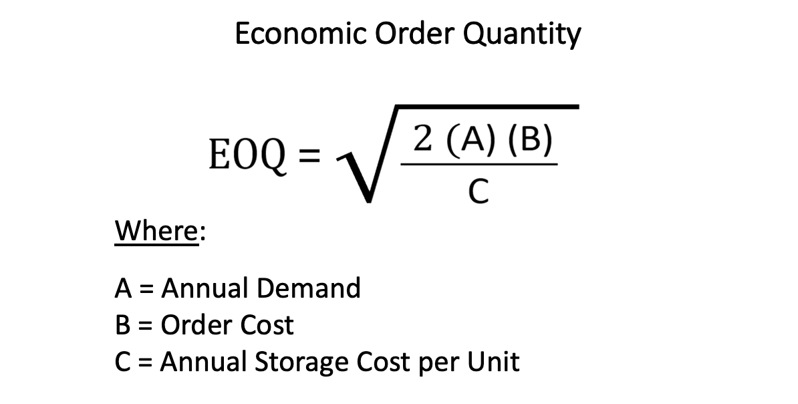Using the EOQ in Ecommerce Inventory Management
Executive Summary
Economic Order Quantity (EOQ) is an often misunderstood formula in inventory management that can be daunting to businesses as they try to do their best to determine the optimal order quantity that minimizes total costs, including holding and order costs.
Note: The EOQ should not be used to determine a factory order. That is not its purpose. It should be used as a backdrop to a properly forecasted order, that takes into account current sales trends, seasonality during the forecast horizon and any manual adjustments the seller makes for upcoming and planned promotional events.
This article is part 1 of a 2-part series that covers the basics of EOQ, its importance, calculation steps, real-world examples, and advanced tips for accurate demand forecasting.
Understanding EOQ Basics in Ecommerce Inventory Management:
Part 1
Introduction to EOQ
EOQ stands for Economic Order Quantity. It’s a fundamental formula used in inventory management to determine the optimal order quantity that minimizes the total cost of inventory, including holding and order costs. This concept has been around for over a century and remains a cornerstone of effective inventory management.
However, having said that, the EOQ best acts as a sounding board for third party ecommerce sellers. Sellers who are purchasing finished goods from factories, rebranding them, and then selling on their own websites and other ecommerce platforms. The EOQ helps inventory managers find the perfect mathematical balance between the cost of ordering inventory and the cost of holding it. By optimizing order sizes,as the theory goes, businesses can reduce excess inventory, minimize storage costs, and avoid stockouts. However, that based on perfect spreadsheet math, not real life for a third party ecommerce seller.
Importance of EOQ in Inventory Management
EOQ is crucial for inventory management as it helps in maintaining an optimal balance between ordering costs and holding costs. By determining the ideal order quantity, businesses can significantly reduce excess inventory, lower storage costs, and prevent stockouts. This optimization leads to more efficient operations and increased profitability.
In the fast-paced world of ecommerce, where customer expectations are high, having the right inventory at the right time is paramount. EOQ helps businesses to avoid the pitfalls of running out of products or holding too much inventory, which can lead to cost savings and improved customer satisfaction.
How to Calculate EOQ
To calculate EOQ, you need the following data:
- Annual Demand (A): The total number of units required per year.
- Order Cost (B): The cost of placing an order, including freight forwarder fees.
- Annual Holding Cost (C): The cost to hold one unit of inventory for a year.
The EOQ formula is:

Where:
- A is the annual demand
- B is the order cost
- C is the annual holding cost per unit
Example Calculation
Let’s walk through an example:
- Annual Demand (A): 22,500 units
- Order Cost (B): $3,000
- Annual Holding Cost (C): $2.40 per unit
Plugging these values into the formula:
EOQ = sqrt((2 * 22,500 * 3,000) / 2.40) = sqrt(56,250,000) = 7,500 units
This means the optimal order quantity is 7,500 units.
Applying EOQ in Your Business
To implement EOQ in your business:
- Calculate Your EOQ: Use the formula provided to determine your optimal order quantity.
- Integrate EOQ into Your Forecasting Models: EOQ should be used in conjunction with your demand forecasting to ensure you order the right quantities at the right times.
- Review and Adjust Regularly: Periodically review your EOQ calculations to account for changes in demand, order costs, and holding costs.
Benefits of Using EOQ
Using EOQ offers several benefits:
- Cost Efficiency: Reduces total inventory costs by balancing order and holding costs.
- Improved Cash Flow: Helps maintain optimal inventory levels, freeing up capital for other uses.
- Inventory Optimization: Minimizes the risk of stockouts and excess inventory.
Common Mistakes to Avoid
When implementing EOQ, avoid these common mistakes:
- Ignoring Demand Variability: Always account for fluctuations in demand.
- Inaccurate Data Collection: Ensure your sales data is accurate and comprehensive.
- Not Updating Forecasts Regularly: Regularly update your forecasts to reflect the latest market conditions.
Real-World Examples of EOQ
Here are some real-world examples:
- Case Study: An online fashion retailer reduced stockouts by 20% and improved customer satisfaction by implementing EOQ.
- Case Study: A tech gadget store optimized their order sizes, reducing excess inventory by 15% and freeing up capital for new product launches.
- Case Study: A multi-channel marketplace improved demand forecasts, increasing stock turnover rate by 25% and reducing holding costs.
Advanced Tips for Accurate Demand Forecasting
For more accurate demand forecasting:
- Integrate Forecasting with Inventory Management Software: Use sophisticated software to automate EOQ calculations and demand forecasts.
- Leverage Predictive Analytics: Analyze market trends, economic indicators, and customer behavior to make informed predictions.
- Regularly Review and Adjust Forecasts: Continuously update your forecasts based on actual sales data and market conditions.
Next Steps
Candidly, your next step should be to watch the video below, then at the end of that video click on the link to watch the next video: “The EOQ – A Depper Dive.” Accurate demand forecasting and EOQ are essential for efficient inventory management. By leveraging historical sales data with the right forecasting models and applying EOQ, businesses can make informed decisions, reduce stockouts, minimize excess inventory, and enhance customer satisfaction.
Ready to take your inventory management to the next level? Implement these steps for effective demand forecasting and visit Inventory Boss and learn how to maximize your profitability by optimizing your inventory. This is the most comprehensive training course and SaaS applicaiton for ecommerce Inventory Management anywhere in the known universe! Get started today!
https://www.youtube.com/watch?v=ANIKx2iXH_Q&t=35s